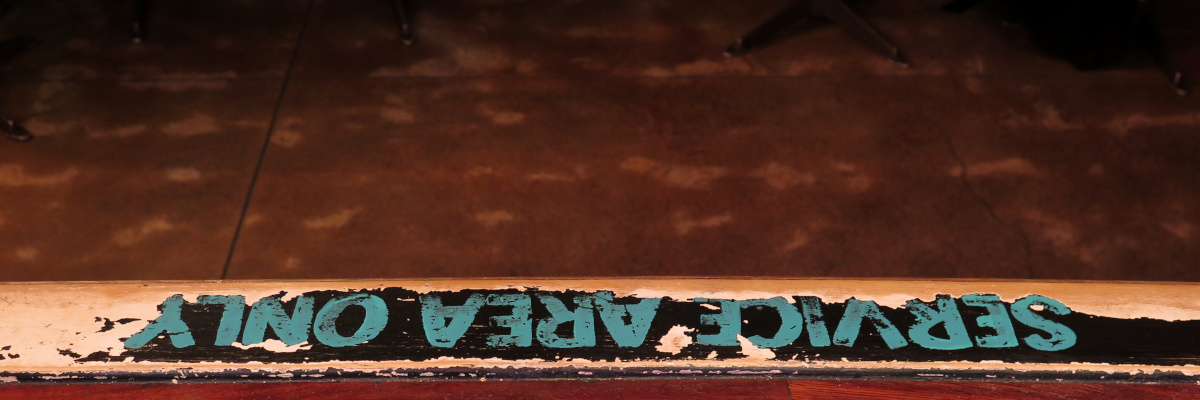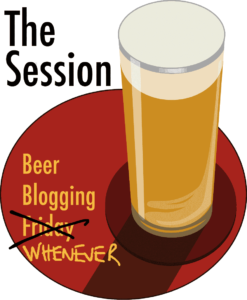
In the brief for the latest round of The Session, Matt Curtis calls for a piece of critical writing about beer or pubs. I feel like that’s what I usually do around here, but I’m going to take his invitation to focus on a particular aspect of bar culture — something that I think very few venues get right, which is both a problem in itself and a handy metaphor for other issues worth fixing. Please, bartenders of the world, I beg you: do not build an unbroken barricade of barstools.
When I’m out for a drink, I love sitting at the bar.1 The vantage point is unbeatable, and it’s adaptable to sociable or solitary moods, with a little shift in body language.2 Time at the bar is part of being a regular, and practically necessary for becoming one, but even in an unfamiliar place I might never revisit, I usually aim to sit there. And nothing is less welcoming than a bar completely fenced-in by furniture; it’s bad enough if it’s all empty, and worse to be greeted by a wall of backs or buttcracks.
 The full end-to-end coverage phenomenon might mostly exist in America; all my new-favourite venues here in D.C. are guilty of it. But it’s not unique to this continent — I spent a bit of time pushing back against it (with mixed success) at Catfish and The Bendigo in Melbourne. And anyway there still are things to consider with fewer stools than the maximum. For starters, zero is not the answer in a bar of any real size; it makes a place feel empty and overly transactional. Too few seats runs the risk of them becoming a de facto staff-only spot, which isn’t much better. And if you merely try to thin them down to what feels like a reasonable number, they’ll all too often be moved into an unworkable mess by people who aren’t thinking of the place as a whole (and shouldn’t have to).
The full end-to-end coverage phenomenon might mostly exist in America; all my new-favourite venues here in D.C. are guilty of it. But it’s not unique to this continent — I spent a bit of time pushing back against it (with mixed success) at Catfish and The Bendigo in Melbourne. And anyway there still are things to consider with fewer stools than the maximum. For starters, zero is not the answer in a bar of any real size; it makes a place feel empty and overly transactional. Too few seats runs the risk of them becoming a de facto staff-only spot, which isn’t much better. And if you merely try to thin them down to what feels like a reasonable number, they’ll all too often be moved into an unworkable mess by people who aren’t thinking of the place as a whole (and shouldn’t have to).
What you need is a Service Area — and the will to enforce it. It doesn’t have to be painted on like it was at Golding’s, in the photo above. There are other, subtler ways to signal or landmark it: Stomping Ground does this well, the long wooden bartop has an overhang to accommodate your knees if you sit, but is punctuated near the taps by cold marble countertops that drop straight down. But the key is having staff who feel able to say “hey, sorry, can I just get you to scooch over this way a bit, we need that spot free for folks to come up.” Because you will get people (dudes, let’s face it) who’ll drag a stool into your nice clear space on a busy night as if they were the only person clever enough to think of sitting there.
I remember talking to Sean — the proprietor and designer — at Golding’s about how well it worked, there. He proudly referred to it as The Moneymaker, and I suspect he’s right that you’d bring in more overall with a gap than with however-many people parked there. But for me, it’s more about easing access and ensuring people feel welcome. It’s no fun, for anyone involved, having to talk (and eventually pass drinks and payment) over someone’s shoulder. And not everything can (or should) be replaced with QR code ordering or delegated to roving floor staff. “Where’s the toilet?” and “That guy over there is being a real creep” are better dealt with directly. For a million different reasons, people just need a moment with a bartender without feeling like they’re intruding or in the way.
Once you’ve internalised this most mundane sense of accessibility, you can keep widening out your attention, smoothing all the points of friction you find in the place and observe people struggling with or bouncing off. That’s the job. It may involve correcting other physical impediments, thinking of people with capacities and characteristics different from your own, and might be something as ephemeral and obscure as being alert to shitty bigoted graffiti and getting rid of it. Maybe the menu needs a rewrite or reposition, perhaps some piece of process could be clearer. If you want folks to feel welcome to come in and to come back, they shouldn’t have to run an obstacle course, however literal or metaphorical.
Matt’s round-up of all the posts from this round is here on his personal blog, Total Ales. There, he reminded me that we’d actually shared a beer at Golding’s; a sublime coincidence that might’ve bubbled up from my subconscious somehow. He wrote about his visit in this long, lovingly-photographed piece for Good Beer Hunting way back in 2018 — in the black-and-white photo beside the one of the front door, that’s me in the Commander Shepherd t-shirt, next to Kieran Haslett-Moore, then of North End Brewery.
- “Sitting at the bar is where things happen” says Luke Robertson, in a sadly-unfinished series about the elements of bar design that I really enjoyed and remembered while writing this. I asked him about it and he passed on some interesting things about barstools themselves and this possible first documented usage.
- Watching out for this — and being able and willing to help facilitate either — is a huge part of bartending, if you ask me. But just keep in mind that staff don’t owe you companionship past a certain point; some customers certainly abuse that dynamic, especially in a tipping culture, but that’s a topic for another time.
